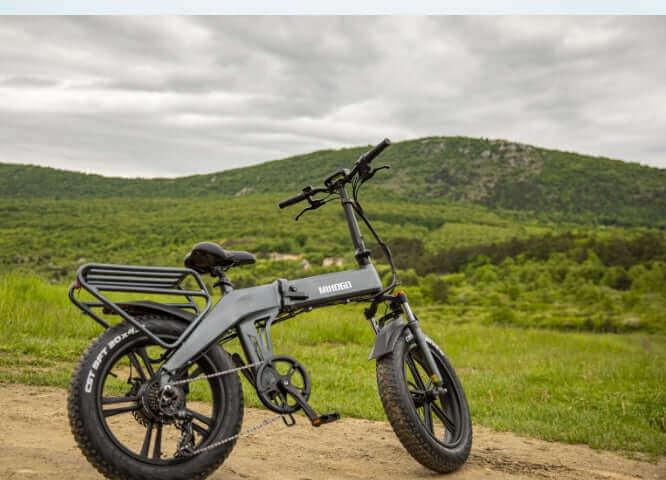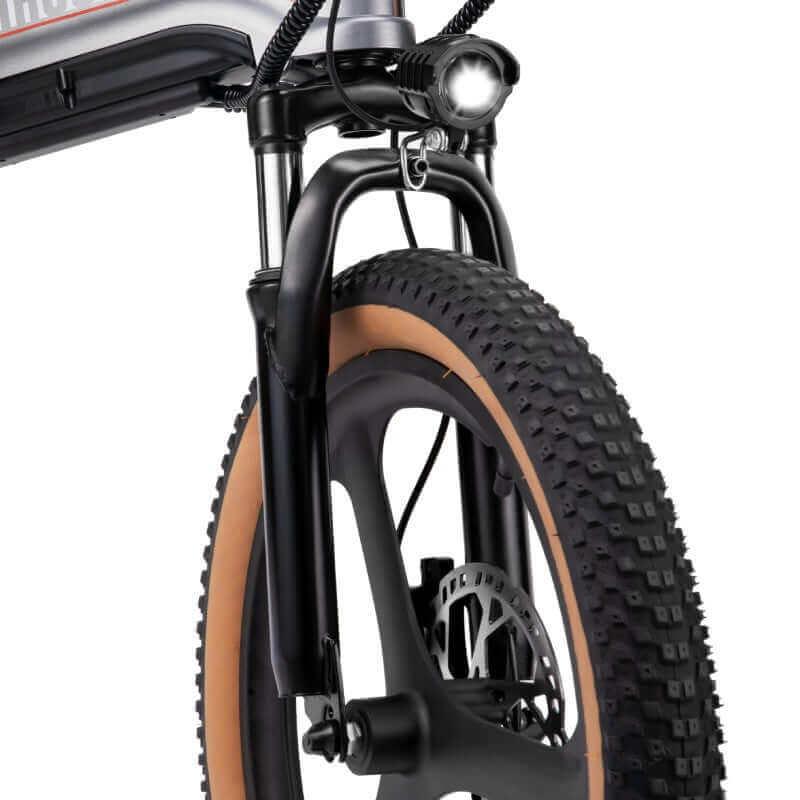How Long Do Ebike Batteries Last?
Lithium Ion batteries are becoming increasingly popular as a reliable and long-lasting power source for many devices and vehicles. How long do lithium ion batteries last? This is an important question to ask when considering the purchase of a device or vehicle powered by lithium ion batteries.
On average, lithium ion batteries can last up to two years with proper care and maintenance. When it comes to ebikes, the battery typically lasts around 500 to 1000 charge cycles. Electric bikes have a battery life of around one to two years with proper care and maintenance. Motorcycle batteries generally last three to five years, depending on the type of battery. Bicycle batteries typically last between two to four years, depending on how often they are used.
In addition to usage, environmental conditions such as temperature and humidity can also affect the lifespan of the battery. Proper storage of the battery can help extend its life. Batteries should be charged regularly to keep them in optimal condition.
When it comes to the longevity of lithium ion batteries, it is important to research the type of battery that is right for your needs and to ensure that the batteries are properly cared for and maintained. With the right care, lithium ion batteries can provide reliable and long-lasting power for many devices and vehicles.
5 Helpful Tips to Ensure a Long Battery Life
Lithium-ion batteries are commonly used to power electric motorcycles, e-bikes, and electric bikes. These batteries are an excellent choice for powering these vehicles because they are lightweight, powerful, and long-lasting. But how long do lithium ion batteries last?
The lifespan of a lithium-ion battery depends on how it is used and how well it is maintained. Generally, a lithium-ion battery can last anywhere from 500 to 2,000 charge cycles. A charge cycle is when the battery is completely drained and then recharged. The lifespan of a lithium-ion battery can be extended by following some simple tips.
Charge your lithium-ion battery regularly and completely. Avoid extreme temperatures when storing your lithium battery. Limit exposure to direct sunlight. Avoid overcharging your battery. Unplug your devices when they’re fully charged. Batteries will degrade over time, but if you follow these steps, you can prolong the life of your battery and ensure that it runs at peak performance.
When it comes to electric motorcycles, e-bikes, and electric bikes, the battery can last anywhere from 500 to 1,000 charge cycles. For motorcycles specifically, the battery life can range from two to five years depending on usage. The same can be said for e-bikes and electric bikes, with the battery lasting anywhere from 500 to 1,000 charge cycles.
Bicycle batteries, both electric and non-electric, can last anywhere from two to five years depending on usage. However, the battery life of a bicycle battery can be extended if the battery is regularly maintained and kept in good.
How to Prolong Your eBike’s Battery Life?
Lithium ion batteries are the go-to power source for electric bikes, electric motorcycles, and other battery-powered vehicles. But how long do these batteries actually last? Generally, lithium ion batteries can last anywhere from 500 to 2,000 charging cycles, depending on the quality of the battery and the way it's used and maintained.
For electric bikes and motorcycles, battery life can vary from around 200 to 1,000 miles depending on the speed and terrain you ride on. To maximize the life of your lithium ion battery, follow these tips:
• Use the right charging techniques, such as avoiding overcharging and using the right charger.
• Avoid leaving the battery in direct sunlight or in a hot environment.
• Store your battery in a cool, dry place if you plan to not use it for a long period of time.
• Only use your battery when it’s fully charged.
• Use the lowest speed setting on your eBike when possible.
• Clean and maintain your bike’s electrical components regularly.
• Avoid running your battery down to empty.
• Disconnect your battery when not in use.
• Consider investing in a high-quality battery for your eBike.
Regular maintenance and proper use of your lithium ion battery will help extend its life and keep it functioning for years to come. Additionally, if you're storing a battery for a long period of time, make sure to charge it every few months to keep it in good condition. With proper care and maintenance, you can keep your lithium ion battery in good condition and maximize its life.
1. Avoid Storing Your Battery in Extreme Cold or Hot Environment
Lithium ion batteries are a popular choice for many electronic devices and vehicles due to their long lifespan and reliable performance. But how long do they last? The answer depends on a number of factors such as storage conditions, usage habits, and the type of device.
When it comes to electric motorcycles, lithium ion batteries can last anywhere from 2-5 years depending on how they’re used and stored. E-bikes typically have a battery life of anywhere from two to five years, although some models may last even longer. For electric bikes, the battery life is typically 1-2 years but can last up to five years with proper care and storage.
When it comes to traditional motorcycles, battery life can range from 2-5 years depending on the model and usage habits. Bicycles, on the other hand, don’t necessarily have a battery but the lifespan of the bike will depend largely on how it’s used and stored.
No matter what type of vehicle you’re using, the lifespan of the battery will degrade over time. This is due to a number of factors such as extreme temperatures, overcharging, and general wear and tear. Therefore, it’s important to take proper care of your battery in order to maximize its longevity.
It’s also important to store your battery in an optimal temperature range (between 10-35 degrees Celsius). Storing your battery in an extreme cold or hot environment can drastically reduce its lifespan. Exposing the battery to extreme heat can cause it to overheat and swell, resulting in irreversible damage.
Climatic intricacies play a pivotal role in the efficacy of lithium-ion batteries. Imagine the scenario: you inadvertently let your battery bask in the blistering embrace of the sun's rays whilst lodged in your vehicle. This act, in essence, curtails the vitality of your battery. In the annals of battery missteps, subjecting a fully juiced battery to balmy climes tops the list. A sage piece of advice? Shun prolonged exposure of your two-wheeler to unrelenting solar illumination. In moments of dormancy, nestle your battery in an ambient sanctuary, ideally not surpassing 20°C (68°F). The illustrative compendium, courtesy of Battery University, delineates the repercussions of thermal variance on a battery's retrievable vigor.
2. Don’t Submerge Your Battery in Water
1000 charges, depending on the type and usage.
•E-bike batteries can last up to 4-5 hours on one charge, depending on the type and usage.
•Batteries degrade over time due to a number of factors including temperature, usage, and age.
•Motorcycle batteries can last up to 5 years, depending on the type and usage.
•Batteries will last longer if stored in a cool, dry place.
•Lithium batteries can last up to 10 years, depending on the type and usage.
3. Store A Battery Partially Charged – But Not Too Low!
Upon scrutinizing the aforementioned illustrative compendium, one discerns the ramifications of storing a battery brimming with energy. Even more pivotal, letting a battery languish in utter depletion might spell calamity. As alluded to earlier, lithium-ion batteries exhibit a proclivity for subtle energy egress, even in moments of quiescence. Descending below a certain voltage threshold might instigate irrevocable cellular harm, contingent on its dormant duration. For optimal conservation during extended hiatuses, it's judicious to ensure its energy reservoir oscillates between roughly 80% and 40%. Some charging apparatuses proffer a diminished 'reservoir' voltage modus; hence, one might pivot to this pre-energizing for sequestration. A facile stratagem would be to indulge in a brief cycling jaunt post a full charge, pre-sequestration.
Moreover, eschew entrusting your battery to a charger's embrace for protracted epochs; basking in a near-full charge diminishes its longevity. Periodically, during the colder months, bestow a cursory glance upon your battery. Should you perceive a notable dwindling in its power gauge, a swift energizing can recalibrate it to the quintessential stowage voltage. Yet, in the absence of a power indicator, it's astute to invigorate the battery for a fleeting half-hour tri-monthly. Always be circumspect and avert stashing a battery in its zenith of charge – though an occasional oversight isn't cataclysmic.
4. Remove your Ebike’s Battery While Transporting
•When not in use, it is important to store lithium-ion batteries in a cool and dry place to maximize battery life.
•Batteries stored in a warm environment will degrade faster than those stored in cooler temperatures.
•When not in use, it is important to regularly check the battery for any signs of damage or wear and tear.
•To extend the life of a lithium-ion battery, it is recommended to charge it fully after every use.
•It is also important to avoid overcharging the battery, as this can cause permanent damage and reduce its lifespan.
•Finally, it is important to remember that batteries degrade over time, regardless of usage, so it is important to check the battery for any signs of damage or wear and tear.
5. Refrain From Habitual Complete Battery Depletion
Astoundingly, in this digital epoch, some tech platforms still champion the notion of frequent full depletions of your battery. Contrary to this antiquated advice, as corroborated by the compendium from Battery University, pushing lithium-ion batteries to their nadir consistently is injurious. It's more salutary to embrace partial depletions, supplementing them with regular minor recharges, to amplify the battery's re-energizing cycle longevity. An infrequent odyssey that necessitates a full drain? Entirely permissible! Lithium-ion batteries, devoid of the notorious 'memory effect' inherent in some battery formulations, flourish when predominantly operated in the upper echelons of their discharge gradient. For those who indulge in brief, sporadic rides, it's slightly more propitious to re-energize post several jaunts rather than post every escapade (forestalling protracted stints at or nearing maximal charge, as previously expounded).

Assiduous upkeep and judicious stowage of your battery, as elucidated prior, can substantially augment its vitality. A lithium-ion battery, when scrupulously attended to, boasts a robust lifespan spanning three to five years. Conversely, neglect can expedite its deterioration, potentially within a mere season.
6. Charging etiquette
Lithium-ion batteries are a popular choice for portable electronics and electric vehicles alike. But how long do they last? The answer depends on a number of factors, including the type of battery, your usage habits, and environmental conditions. Generally, lithium-ion batteries have a lifespan of 2-3 years with proper care and maintenance.
For electric motorcycles, the lithium-ion battery is a key component. How long do they last? Generally, electric motorcycle batteries last from 1-3 years, depending on the model. With proper care and maintenance, these batteries can last even longer.
E-bikes, or electric bicycles, also use lithium-ion batteries. These batteries typically last from 500-1000 charge cycles, depending on the type and quality of the battery. On average, one charge cycle is equivalent to about 50-100 miles of riding. This means that a typical e-bike battery can last anywhere from 25,000 to 50,000 miles of riding.
Motorcycle batteries, on the other hand, last much longer. The average lifespan of a motorcycle battery is 3-5 years with proper care and maintenance. Batteries for bicycles typically last between 1-2 years, depending on usage.
Batteries will degrade over time, no matter how well they are cared for. This is due to chemical reactions inside the battery that cause it to lose capacity. To maximize the lifespan of your battery, make sure to charge it when it drops below 20%, avoid charging it in extreme temperatures, and use the original charger for your device. Additionally, avoid storing your battery in extreme temperatures or direct sunlight.
How long does a lithium ion battery last in an electric motorcycle?
•Ebike batteries last between 1 to 5 years on average, depending on usage. Quality batteries can last up to 10 years or more.
•Regular charging and proper maintenance of your ebike battery can help to extend its life. Keeping your battery at a full charge when not in use can help to extend its life, while discharging your battery to 0% regularly will significantly reduce its lifespan.
•Temperature also affects the life of an ebike battery, with extreme heat or cold temperatures drastically reducing the life of the battery.
•The life of a motorcycle battery can vary, with proper maintenance and care a battery can last up to 4-5 years.
•Regular usage and keeping your battery at a full charge when not in use can help to extend the life of a motorcycle battery.
•Bicycle batteries can last up to 2 years on average, depending on usage. Quality batteries can last up to 5 years or more.
•How long bikes last depends on the material used and the type of bike. Bikes made from quality materials can last up to 10 years or more.
•Lithium batteries in electric bikes can last up to 5 years or more, depending on usage. Proper maintenance and care of your battery can help to extend its life.
•Batteries degrade over time, so it's important to check your battery regularly and replace it if necessary. Batteries should also be stored at room temperature and kept away from extreme temperatures.
How long do e-bike batteries last on one charge?
Battery life is an important factor when considering an electric bike, motorcycle, or bicycle purchase. Lithium ion batteries are the most commonly used type of rechargeable battery in electric and hybrid vehicles, and they typically last for around three years. However, the actual lifespan can vary greatly based on factors such as how often it is used, how it is stored, and the type of battery.
Electric bike batteries can last up to 1,000 cycles on a single charge, depending on the battery type and its usage. Motorcycle batteries can last up to three to five years, depending on the battery type, how often it is used, and how it is stored. Similarly, bicycle batteries can last up to two to three years, while electric bike batteries can last up to two to four years depending on the battery type and how it is used and stored.
Temperature, charging habits, and how often the battery is used are the primary factors that affect battery life. To extend the life of a lithium ion battery, it should be stored in a cool, dry place. Additionally, regularly checking and maintaining the battery can help ensure that it is performing optimally.
How long do batteries last in storage?
Lithium ion batteries are a popular choice for electric vehicles, including electric motorcycles and e-bikes. But how long do these batteries last? The answer depends on a variety of factors, including how the battery is used and maintained, how long it is stored, and the type of battery.
When it comes to storage, lithium ion batteries can last up to 10 years if they are maintained properly. Electric bike batteries typically last up to 5 years, while motorcycle batteries can last up to 3 years. Bicycle batteries can last up to 1 year.
When it comes to use, the life of a lithium ion battery depends on how often it is used and how it is maintained. Proper maintenance and care will help maximize the life of the battery, so it's important to follow manufacturer instructions and regularly inspect and clean the battery.
One of the main reasons why batteries degrade is due to the chemical reaction that occurs as the battery charges and discharges. This reaction causes the battery to become less efficient, which can lead to shorter battery life. It's also important to note that extreme temperatures can also affect battery life, so it's important to keep the battery in a cool environment if possible.
Overall, the life of a lithium ion battery can vary depending on how it is used and maintained. Proper care and maintenance will help ensure the battery lasts as long as possible. Additionally, storing the battery in a cool environment and regularly inspecting it can help extend its life.








